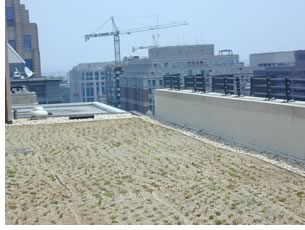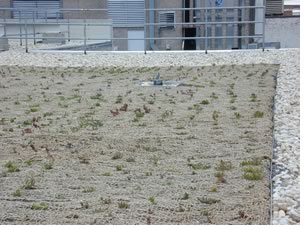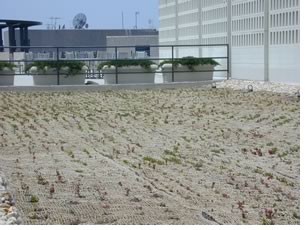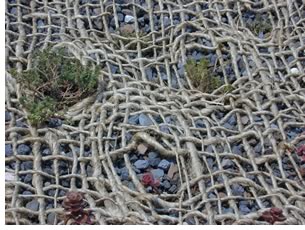

08/2004
Sedums Grow in Downtown
Washington
Green roof gets neighbors’ attention
by Heather Livingston and Tracy Ostroff
 In
architecturally sedate Washington, D.C., it appears that the green roof
phenomenon has at last taken root. At 1425 K Street, NW, in the heart
of the business district, a public/private collaboration among Blake Real
Estate, Casey Trees Endowment, and DC Greenworks has yielded the city’s
first commercial green roof. At 3,500 square feet, the roof will provide
a weather monitoring station for a local news affiliate, a rainwater control
area, and, perhaps most importantly, a sliver of nature in the midst of
the nation’s capital. Eager to see how a rooftop can provide an
urban oasis, AIArchitect arranged
a tour with Barbara Deutsch, senior director, programs and research for
Casey Trees, and Kelliann Whitley, property manager for Blake Real Estate.
In
architecturally sedate Washington, D.C., it appears that the green roof
phenomenon has at last taken root. At 1425 K Street, NW, in the heart
of the business district, a public/private collaboration among Blake Real
Estate, Casey Trees Endowment, and DC Greenworks has yielded the city’s
first commercial green roof. At 3,500 square feet, the roof will provide
a weather monitoring station for a local news affiliate, a rainwater control
area, and, perhaps most importantly, a sliver of nature in the midst of
the nation’s capital. Eager to see how a rooftop can provide an
urban oasis, AIArchitect arranged
a tour with Barbara Deutsch, senior director, programs and research for
Casey Trees, and Kelliann Whitley, property manager for Blake Real Estate.
Whitley said that when they began the project about two years ago, few people connected with the real estate company even knew what a green roof was. Now, the company is fully behind the concept and plans to implement green roofs on its other buildings as their roof decks need to be replaced. And why not? Apart from the inherent public air and water quality benefits and the private financial benefits, Blake has received significant attention from companies pursuing LEED™ certification that have embraced the project as an exemplar of best management practice.
 Not
your father’s roof garden
Not
your father’s roof garden
Our guides explained that a green roof and a roof garden are very different.
Whereas a roof garden, like the one atop Rockefeller Center in New York
City, typically has about six inches of soil and may include non-indigenous
flowering plants, grasses, and trees, a green roof consists of low-maintenance
plants that require little soil and no watering. This particular green
roof boasts 9,730 plants made up of 11 species of sedums—ground-covering
succulents that can withstand dramatic temperature variations—native
to Alpine conditions.
DC Greenworks, a design-build firm, raised $60,000 for the project and served as the general contractor. They also coordinated a team of young adults from Covenant House, a national nonprofit agency that serves at-risk youth, who hand-planted the sedums. The building’s concrete roof deck was covered with a waterproof membrane, an electronic leak detection system, polystyrene insulation, geotextile filter fabric, root barrier/drainage course, three inches of engineered soil, and, finally, the sedums. A biodegradable jute covering holds the plants in place until they are fully established—a period of one to two years. Casey Trees will provide volunteers to monitor the green roof, an important part of the research and demonstration project. The Chesapeake Bay Small Watershed Grand Program—administered by the National Fish and Wildlife Foundation and the Watershed Protection Division of the D.C. Department of Health—is providing additional financial support.
 Going
green to save some green
Going
green to save some green
DC Greenworks Executive Director Dawn Gifford said many clients and architects
are interested in incorporating green roofs into their buildings but shy
away from the process once they are presented with cost estimates. But,
she said, the estimates are often needlessly high because they result
from an “overdesigned” program. The plans, she said, often
stem from architects and engineers relying on specifications for “intensive
green roofs” that are too much for the project and budget. That’s
why it’s important not only to have the architectural and engineering
component, she said, but to have a partner with horticultural expertise
to parse out the specifications for soil and plant requirements.
Built in the late 1960s, 1425 K Street was re-roofed a couple of years ago and should not have needed a new roof for at least another 10–15 years, Whitley said. So what made Blake invest in a green roof? Initially, the push was made by tenant Casey Trees, a local nonprofit whose mission is to restore, enhance, and protect the tree canopy of Washington, D.C. Not surprisingly, Blake—a family-run company with 11 buildings—was skeptical. According to Whitley, this Class A building is the “jewel in Blake’s real estate crown.” So, like any good client, they asked a number of questions and exhaustively researched the project and process.
 What
Blake discovered surprised them: Green roofs last two to five times longer
than traditional roofs, require less maintenance, save energy by regulating
temperature variations, reduce sound pollution, lower storm-water utility
fees, receive energy tax credits, and increase property values. And, in
this case, it provides tenants access to private green space, a psychological
benefit that’s sure to contribute to tenant satisfaction and an
increase in occupancy rates. Echoing Gifford’s admonition to involve
a green consultant at the project outset, Whitley advised, “Do your
homework and keep it simple.”
What
Blake discovered surprised them: Green roofs last two to five times longer
than traditional roofs, require less maintenance, save energy by regulating
temperature variations, reduce sound pollution, lower storm-water utility
fees, receive energy tax credits, and increase property values. And, in
this case, it provides tenants access to private green space, a psychological
benefit that’s sure to contribute to tenant satisfaction and an
increase in occupancy rates. Echoing Gifford’s admonition to involve
a green consultant at the project outset, Whitley advised, “Do your
homework and keep it simple.”
Personal observations
But what impressed us most about the green roof is that people actually
use it; they were coming and going throughout our one-hour rooftop tour.
(Granted, many of them were smokers in search of refuge, but it has the
potential to become a place of quiet solitude.) As the plants grow in,
they will absorb not only air pollution but also noise pollution, lessening
the din of the city below. And the vision of the potential collaborative
is beautiful: a city filled with visually pleasing green roofs that collectively
will lessen sewage pollution by reducing storm-water runoff as much as
56 percent, create healthier air in a region that suffers from poor air
quality throughout the summer, and reduce heat islands. Green-roofed buildings
have the potential of reducing rooftop ambient temperatures from 155 degrees
to 86 degrees. Eighty-six degrees in Washington, D.C. in August—now
that’s an oasis!
Copyright 2004 The American Institute of Architects.
All rights reserved. Home Page ![]()
![]()
 |
||
| Photos by Heather Livingston.
|
||